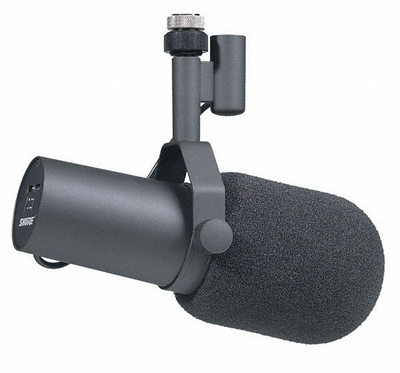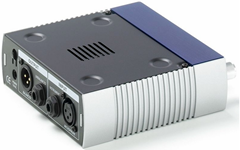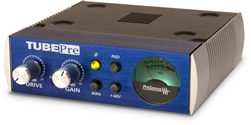Over the Christmas break, I decided to replace my great Samson
C01U mic with something a little more high end. Today was the first
day I really got to try it out at work.
Criteria
I knew I wanted a new mic, but there were some specific things I
was looking for. For the new one, I had the following criteria:
- Not a USB mic. Straight XLR
- Must sound good for close-talking voice overs
- Must be well under $500
- Visually needs to let me see more of my screen (more on that in
a second)
- Similar to the last one, it needs to mount on my boom arm, and
not require desk space when not in use
Why not USB?
My C01U USB mic worked well, but it was very picky about the
juice in the USB line. Depending on what else was running (even
with a powered hub) it would sometimes produce really low volume
output. In addition, it took up a lot of USB bandwidth while in
use. Recognizing that, I made sure to hook up my MOTU using
Firewire instead of USB. Still, I have a TON of USB devices hanging
off my machine, and I just needed to eliminate this one. The MOTU
has balanced mic inputs and plenty of DSP to spare.
The use and price should be easy to understand. I use my mic for
Skype and Lync calls almost every weekday, sometimes on podcasts
with other folks, and when recording narration for the videos I
create (which I plan to do even more in 2012). My office is not
silent. There's a fridge behind me, and my PC itself produces more
noise than I'd want in video (I'm picky). Also, some mics
(especially headset mics) pick up keyboard taps as loud thumps. I
can't have any of that.
Seeing my Screen!
When recording a video showing how to use an app or write some
code, it helps if I could actually see my screen at the same time.
The Samson had a largish shock mount and then a big pop screen. If
I ran it without the pop screen (as I did later), the plosives would come through on the recordings
as very loud spikes. I spent a bit of time editing them out for the
latest Silverlight videos, but I didn't get them all. Small pop
screens weren't worth the effort as they were hard to position and
also just didn't work well. You should have seen the neck
contortion to see my screen with a mic in my face.
The C01U
My C01U is still a good microphone. If you don't have an
external audio interface with balanced mic inputs and good preamps,
I wouldn't hesitate to to recommend it to someone looking for a USB
microphone. In fact, I've recommended it to many others, with the
caveat about USB power. Several of the Blue
mics are also good to check out.
The SM7B

The mic I finally decided on is the Shure SM7B. This is a broadcast quality mic,
but still within the price range of most mortals. The cardiod
pickup pattern helps reduce the amount of keyboard and background
noise that makes it into the recording.
I decided on this mic after a lot of research. Initially I
looked at condensor mics, but came to the conclusion that at my
price range, they're all a bit meh. Granted, I didn't get a chance
to actually use any in-person, so I was only able to go by
recordings, reviews, and feedback on the web.
Why did I pick this mic?
- Industry standard sound, often used in talk radio and video
voice overs. Optimized for those scenarios, but useful in many
others.
- Does not need a separate shock mount
- Does not need an external pop filter even when used in
close-mic applications.
- Has good shielding for use around computers and other equipment
(have you seen my desk?)
- Price was within budget
I use this mic with the large close-mic foam windscreen over the
end. I even like the way that looks a bit better. It's also still
smaller than most pop filters.
Here's a good review of the SM7B at TweakHeadz.
Preamp
The SM7B needs a powerful preamp. That was a bit of a surprise
when I picked it up, as I thought my MOTU would be sufficient. The
52db of gain available on the MOTU 828mkIII may be appropriate for
a condensor mic, but I got almost nothing out of the SM7B with the
gain cranked all the way up. After a bunch of research I made two
decisions:
- I really want to build my own preamp based on plans/kits on the
web. They're just cool electronics projects with significant
opportunity for high-voltage electrocution. I can't resist!
- I need something fairly inexpensive but decent to work with
until I get around to building my own.
So, I went to the local Guitar Center and picked up a PreSonus
TUBEPre. This is a tube-based 1/3 width 1U high microphone pre-amp.
It sounds decent enough, although you can replace the inexpensive
Chinese 12AX7 tube for further customization of the sound. There's
a VU meter on the front, but it isn't particularly useful and is
more just for eye candy unless you're screaming into the mic.


Surprisingly, the TubePre gain only goes up to about 40db.
However, it sounds louder and cleaner than the MOTU at the full
52db gain setting. I haven't investigated why.
I found a number of cool plans and kits for building your own
preamp. They all tended to run several hundred dollars in
parts, but that's still a lot cheaper than most "good" preamps.
More on those when I decide to build one.
In the end…
The mic sounds great, although I am still tweaking it (and the
preamp and eq) to see what things I like and don't. In the end,
typical video compression renders a lot of the nuance from the
preamp and mic pretty much undetectable. That's ok, though, as I'll
create the best possible source recordings, and enjoy myself while
doing it. It just feels better to work with good equipment.
